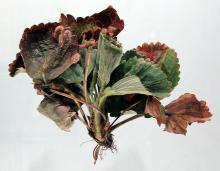Cause Macrophomina phaseolina is a soilborne fungus that is favored by dry and warm soil conditions. Although the pathogen has an extensive host range, this form of the fungus is specific to strawberry. Disease development is enhanced by high temperature, soil water deficit, strawberry monoculture, and sandy soils. The fungus produces microsclerotia for long-term survival and dispersal in the soil. In the past, these structures germinate when soil temperatures are around 86°F but may have become adapted to slightly cooler soil conditions of Northern CA and Oregon. Microsclerotia in the soil infect new strawberry plants each season. The microsclerotia are produced in the host tissue and released into the soil as the infected plant decays. The disease is on the increase in California and Florida strawberry industries on fields that have not been fumigated. In California, the cultivar 'Osceola' was highly resistant, whereas 'Festival', 'Sweet Ann', and 'Ruby June' were highly susceptible. First found in southern Oregon in 2014.
Symptoms Plants in discrete patches in the field show wilting of foliage, drying and death of older leaves, plant stunting, and eventual collapse and death. When plant crowns are cut open, internal vascular and cortex tissues are dark brown to orange brown. May look similar to Fusarium or Verticillium wilt.
Cultural control
- Plant certified stock on well-drained fertile soil adapted to strawberry production. Use resistant cultivars if available.
- While planting, keep roots from getting dry, and set plants at the proper depth.
- Use long crop rotation in commercial plantings; include grasses and grains in the rotation.
- Anaerobic Soil Disinfestation may be helpful even in the PNW. First rice bran is incorporated into the soil followed by irrigation to near field capacity. Then place clear oxygen impermeable plastic (such as anti-condensation film) on the prepared ground. This summer treatment needs to reach soil temperatures of 90°F. Use in combination with other techniques.
- Use white-striped plastic-mulched beds as opposed to using black plastic mulch.
- Do not plant strawberries on land with a recent history of this disease.
Chemical control Preplant fumigation.
- Basamid G. Avoid application when soil is over 90°F. Do not apply within 3 to 4 feet of growing plants. 5-day reentry Restricted-use pesticide.
- Dominus at 10 to 40 gal/A. Apply as a shank injection to an entire field or during raised bed formation when soil temperatures are above 60°F but not greater than 90°F. 5-day reentry.
- Telone C-17 at 27 to 41 gal/A broadcast on mineral soils. Allow 2 to 3 weeks between application and planting or until odor leaves the soil. Do not treat extremely heavy soils. 5-day reentry. Restricted-use pesticide.
- Topsin 4.5 FL at 20 fl oz/A applied through buried drip irrigation. Do not apply within 1 day of harvest. Group 1 fungicide. 24-hr reentry.
- Vapam HL at 37.5 to 75 gal/A. Immediately roll the soil and follow up with tarps or a light watering. May use through an irrigation system. 5-day reentry. Restricted-use pesticide.
At planting and postplant application
- Rhyme at 7 fl oz/A applied through drip irrigation then another 14 days later. May be applied day of harvest. Group 3 fungicide. 12-hr reentry.
References Baggio, J. S., Ruschel, R. G., Noling, J. W. and Peres, N. A. 2021. Physical, Cultural, and Chemical Alternatives for Integrated Management of Charcoal Rot of Strawberry. Plant Disease, 105:295-304.
Koike, S.T. 2008. Crown rot of strawberry caused by Macrophomina phaseolina in California. Plant Disease 92:1253.
Wang, Y. C., Mansouripour, S. M., Hewavitharana, S. S. and Holmes, G. J. 2024. Effect of Cultivar and Temperature on Disease Development of Macrophomina Root Rot in Strawberry. Plant Health Progress, 25:255-261.



